Self-Awareness and its Impact on Personal and Professional Life
VerifiedAdded on 2022/10/10
|9
|2897
|62
Report
AI Summary
This report delves into the critical role of self-awareness in personal and professional development. It examines key aspects such as personality traits, values, motivators, emotional intelligence, leadership styles, power dynamics, and decision-making processes. The report emphasizes the importance of understanding one's strengths and weaknesses to foster career growth and achieve desired goals. It explores different frameworks and theories related to these areas, including personality assessments like the Myers-Briggs test, motivational theories by Maslow and Herzberg, and various leadership approaches. Furthermore, the report discusses the significance of emotional intelligence in navigating workplace dynamics and making sound decisions, while also touching upon the influence of power and organizational politics. The author reflects on their own experiences and insights within the hospitality sector, highlighting the practical application of these concepts in real-world scenarios and emphasizing the importance of continuous self-assessment for career advancement.
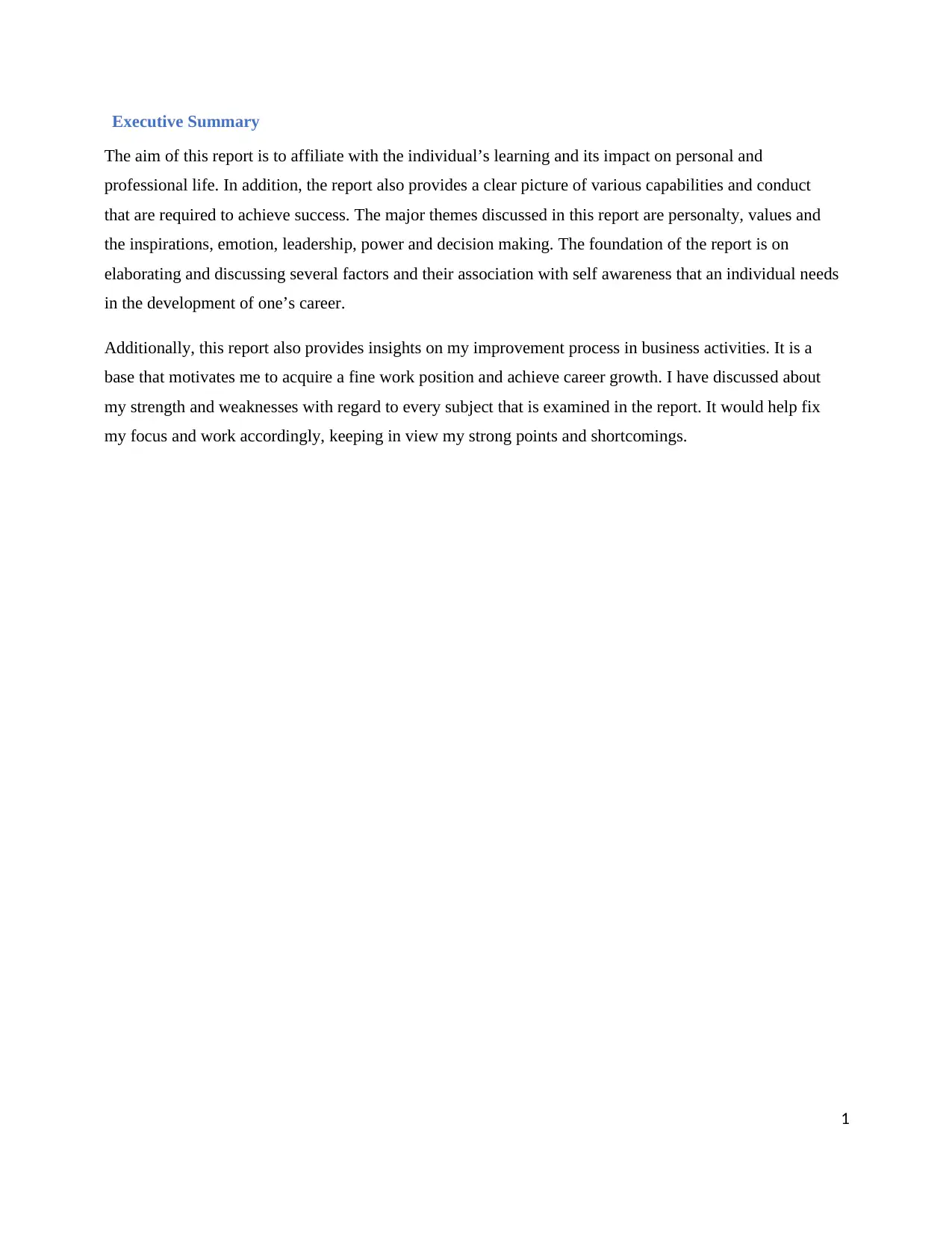
Executive Summary
The aim of this report is to affiliate with the individual’s learning and its impact on personal and
professional life. In addition, the report also provides a clear picture of various capabilities and conduct
that are required to achieve success. The major themes discussed in this report are personalty, values and
the inspirations, emotion, leadership, power and decision making. The foundation of the report is on
elaborating and discussing several factors and their association with self awareness that an individual needs
in the development of one’s career.
Additionally, this report also provides insights on my improvement process in business activities. It is a
base that motivates me to acquire a fine work position and achieve career growth. I have discussed about
my strength and weaknesses with regard to every subject that is examined in the report. It would help fix
my focus and work accordingly, keeping in view my strong points and shortcomings.
1
The aim of this report is to affiliate with the individual’s learning and its impact on personal and
professional life. In addition, the report also provides a clear picture of various capabilities and conduct
that are required to achieve success. The major themes discussed in this report are personalty, values and
the inspirations, emotion, leadership, power and decision making. The foundation of the report is on
elaborating and discussing several factors and their association with self awareness that an individual needs
in the development of one’s career.
Additionally, this report also provides insights on my improvement process in business activities. It is a
base that motivates me to acquire a fine work position and achieve career growth. I have discussed about
my strength and weaknesses with regard to every subject that is examined in the report. It would help fix
my focus and work accordingly, keeping in view my strong points and shortcomings.
1
Paraphrase This Document
Need a fresh take? Get an instant paraphrase of this document with our AI Paraphraser
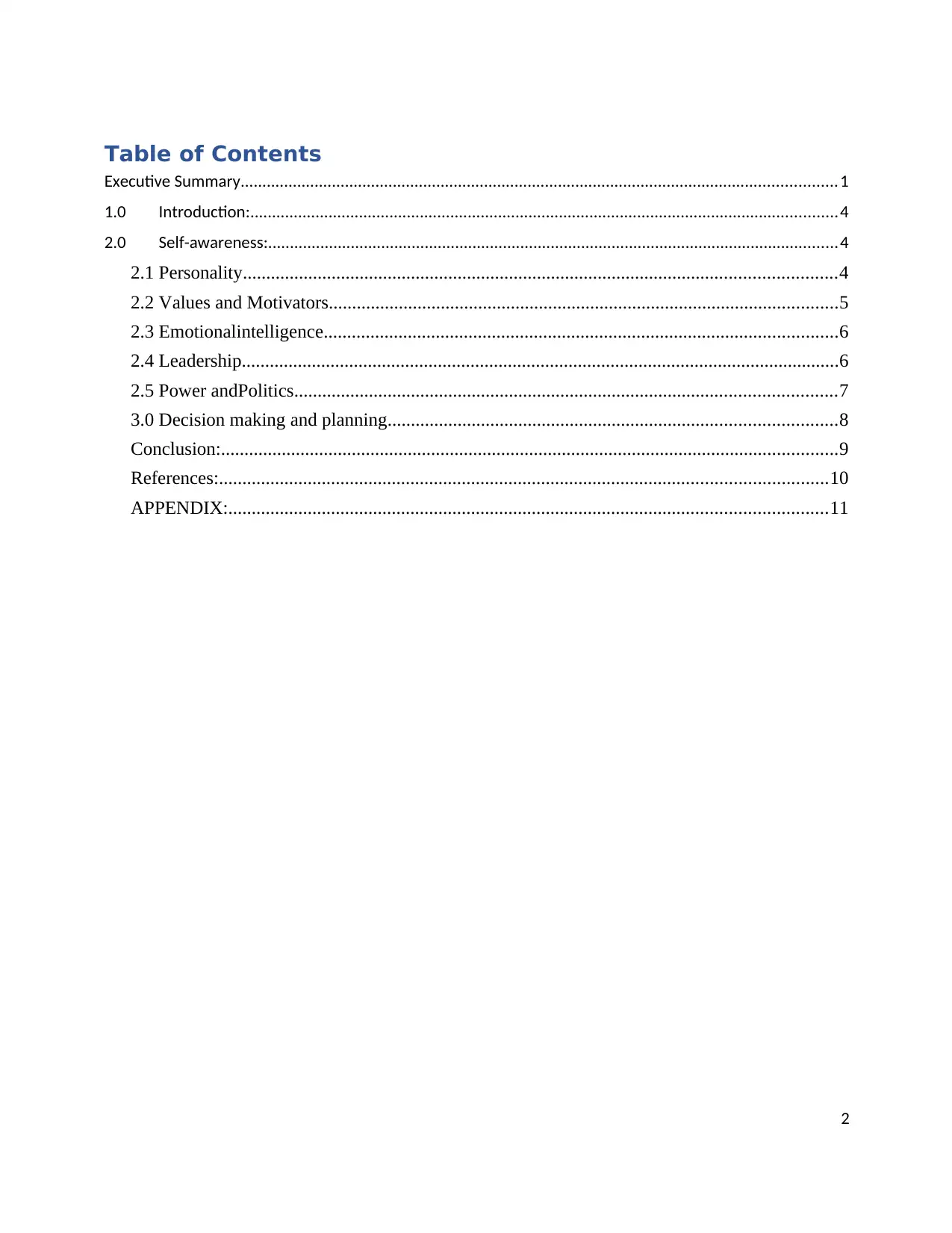
Table of Contents
Executive Summary.........................................................................................................................................1
1.0 Introduction:.......................................................................................................................................4
2.0 Self-awareness:...................................................................................................................................4
2.1 Personality...............................................................................................................................4
2.2 Values and Motivators.............................................................................................................5
2.3 Emotionalintelligence..............................................................................................................6
2.4 Leadership................................................................................................................................6
2.5 Power andPolitics....................................................................................................................7
3.0 Decision making and planning................................................................................................8
Conclusion:....................................................................................................................................9
References:..................................................................................................................................10
APPENDIX:................................................................................................................................11
2
Executive Summary.........................................................................................................................................1
1.0 Introduction:.......................................................................................................................................4
2.0 Self-awareness:...................................................................................................................................4
2.1 Personality...............................................................................................................................4
2.2 Values and Motivators.............................................................................................................5
2.3 Emotionalintelligence..............................................................................................................6
2.4 Leadership................................................................................................................................6
2.5 Power andPolitics....................................................................................................................7
3.0 Decision making and planning................................................................................................8
Conclusion:....................................................................................................................................9
References:..................................................................................................................................10
APPENDIX:................................................................................................................................11
2
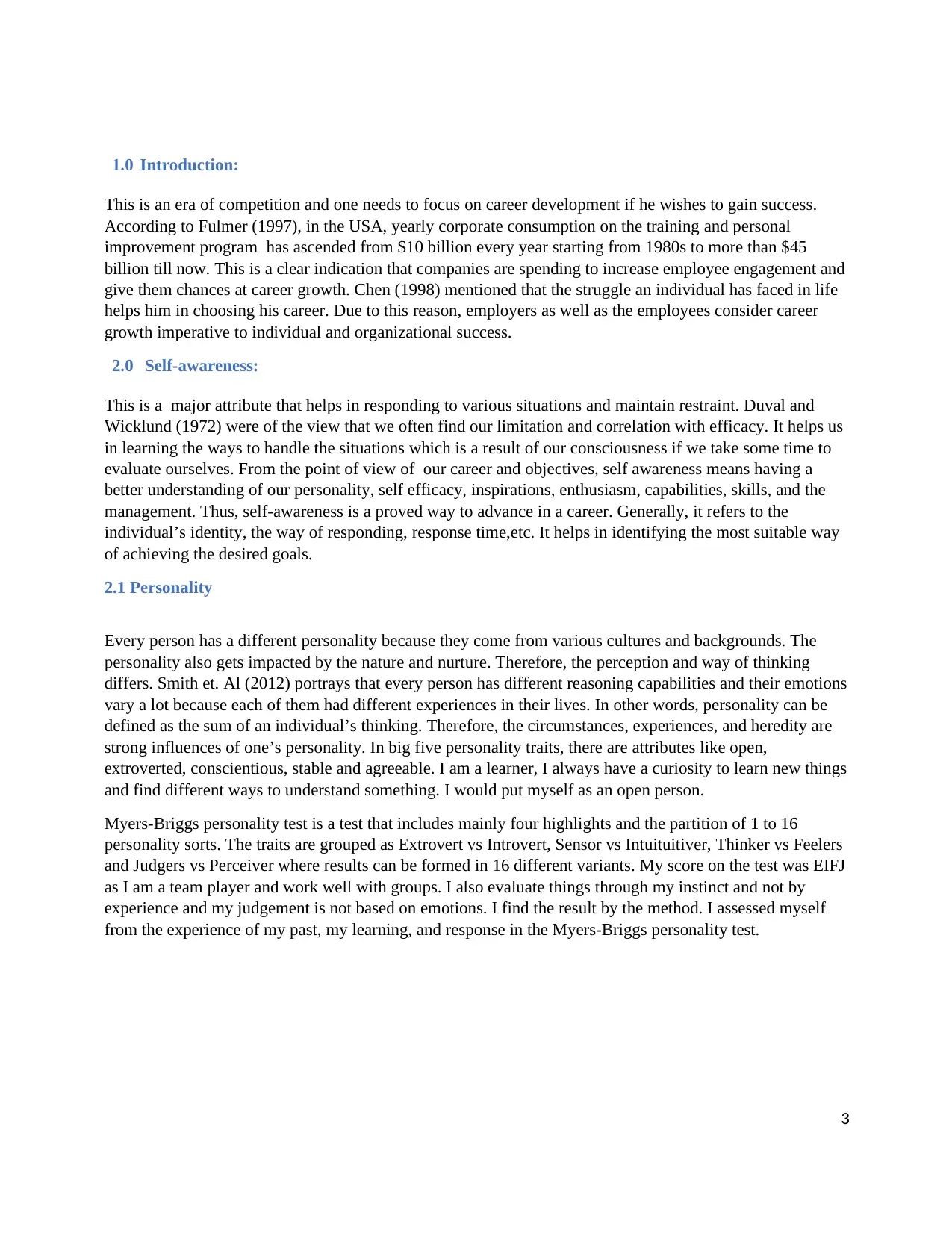
1.0 Introduction:
This is an era of competition and one needs to focus on career development if he wishes to gain success.
According to Fulmer (1997), in the USA, yearly corporate consumption on the training and personal
improvement program has ascended from $10 billion every year starting from 1980s to more than $45
billion till now. This is a clear indication that companies are spending to increase employee engagement and
give them chances at career growth. Chen (1998) mentioned that the struggle an individual has faced in life
helps him in choosing his career. Due to this reason, employers as well as the employees consider career
growth imperative to individual and organizational success.
2.0 Self-awareness:
This is a major attribute that helps in responding to various situations and maintain restraint. Duval and
Wicklund (1972) were of the view that we often find our limitation and correlation with efficacy. It helps us
in learning the ways to handle the situations which is a result of our consciousness if we take some time to
evaluate ourselves. From the point of view of our career and objectives, self awareness means having a
better understanding of our personality, self efficacy, inspirations, enthusiasm, capabilities, skills, and the
management. Thus, self-awareness is a proved way to advance in a career. Generally, it refers to the
individual’s identity, the way of responding, response time,etc. It helps in identifying the most suitable way
of achieving the desired goals.
2.1 Personality
Every person has a different personality because they come from various cultures and backgrounds. The
personality also gets impacted by the nature and nurture. Therefore, the perception and way of thinking
differs. Smith et. Al (2012) portrays that every person has different reasoning capabilities and their emotions
vary a lot because each of them had different experiences in their lives. In other words, personality can be
defined as the sum of an individual’s thinking. Therefore, the circumstances, experiences, and heredity are
strong influences of one’s personality. In big five personality traits, there are attributes like open,
extroverted, conscientious, stable and agreeable. I am a learner, I always have a curiosity to learn new things
and find different ways to understand something. I would put myself as an open person.
Myers-Briggs personality test is a test that includes mainly four highlights and the partition of 1 to 16
personality sorts. The traits are grouped as Extrovert vs Introvert, Sensor vs Intuituitiver, Thinker vs Feelers
and Judgers vs Perceiver where results can be formed in 16 different variants. My score on the test was EIFJ
as I am a team player and work well with groups. I also evaluate things through my instinct and not by
experience and my judgement is not based on emotions. I find the result by the method. I assessed myself
from the experience of my past, my learning, and response in the Myers-Briggs personality test.
3
This is an era of competition and one needs to focus on career development if he wishes to gain success.
According to Fulmer (1997), in the USA, yearly corporate consumption on the training and personal
improvement program has ascended from $10 billion every year starting from 1980s to more than $45
billion till now. This is a clear indication that companies are spending to increase employee engagement and
give them chances at career growth. Chen (1998) mentioned that the struggle an individual has faced in life
helps him in choosing his career. Due to this reason, employers as well as the employees consider career
growth imperative to individual and organizational success.
2.0 Self-awareness:
This is a major attribute that helps in responding to various situations and maintain restraint. Duval and
Wicklund (1972) were of the view that we often find our limitation and correlation with efficacy. It helps us
in learning the ways to handle the situations which is a result of our consciousness if we take some time to
evaluate ourselves. From the point of view of our career and objectives, self awareness means having a
better understanding of our personality, self efficacy, inspirations, enthusiasm, capabilities, skills, and the
management. Thus, self-awareness is a proved way to advance in a career. Generally, it refers to the
individual’s identity, the way of responding, response time,etc. It helps in identifying the most suitable way
of achieving the desired goals.
2.1 Personality
Every person has a different personality because they come from various cultures and backgrounds. The
personality also gets impacted by the nature and nurture. Therefore, the perception and way of thinking
differs. Smith et. Al (2012) portrays that every person has different reasoning capabilities and their emotions
vary a lot because each of them had different experiences in their lives. In other words, personality can be
defined as the sum of an individual’s thinking. Therefore, the circumstances, experiences, and heredity are
strong influences of one’s personality. In big five personality traits, there are attributes like open,
extroverted, conscientious, stable and agreeable. I am a learner, I always have a curiosity to learn new things
and find different ways to understand something. I would put myself as an open person.
Myers-Briggs personality test is a test that includes mainly four highlights and the partition of 1 to 16
personality sorts. The traits are grouped as Extrovert vs Introvert, Sensor vs Intuituitiver, Thinker vs Feelers
and Judgers vs Perceiver where results can be formed in 16 different variants. My score on the test was EIFJ
as I am a team player and work well with groups. I also evaluate things through my instinct and not by
experience and my judgement is not based on emotions. I find the result by the method. I assessed myself
from the experience of my past, my learning, and response in the Myers-Briggs personality test.
3
⊘ This is a preview!⊘
Do you want full access?
Subscribe today to unlock all pages.

Trusted by 1+ million students worldwide
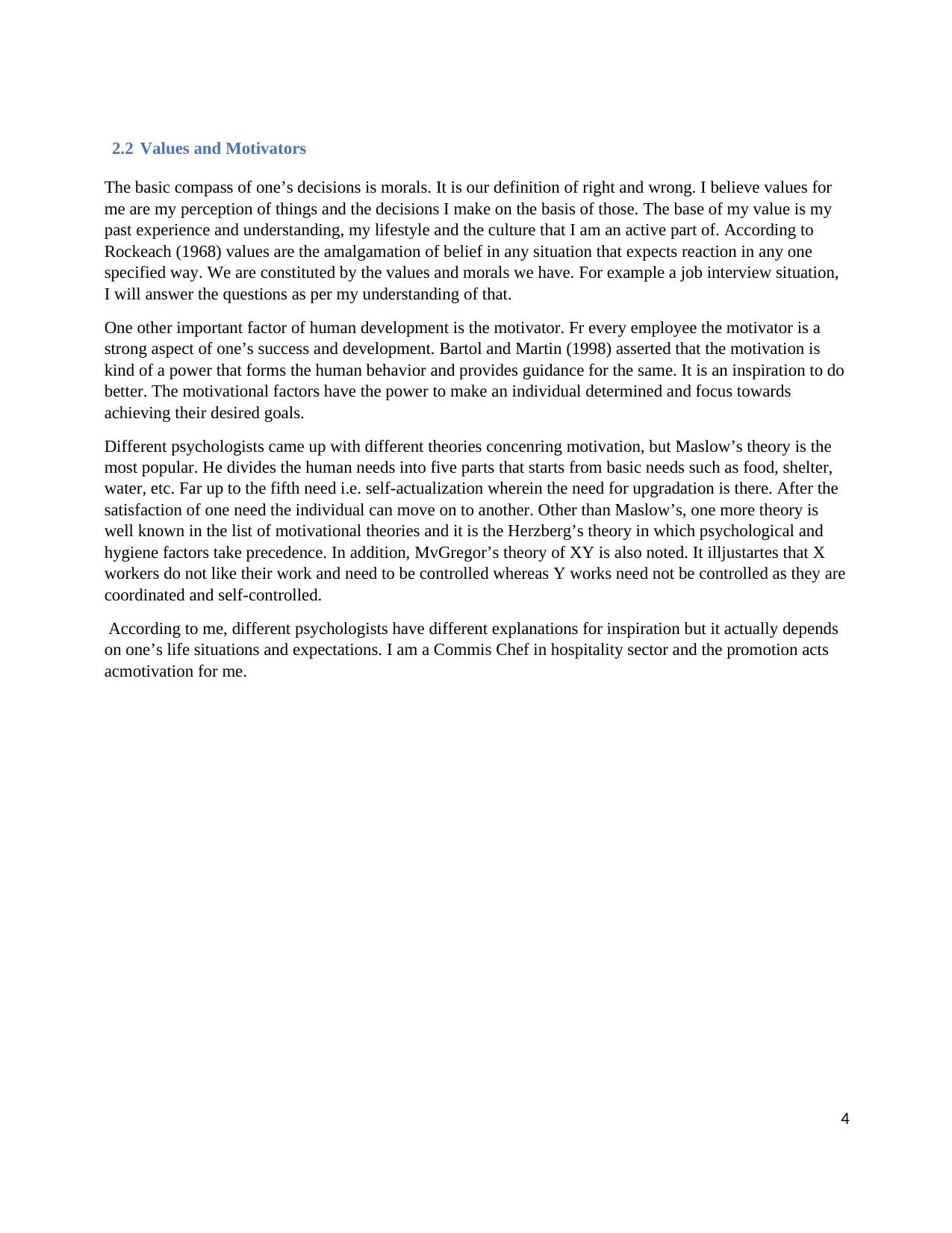
2.2 Values and Motivators
The basic compass of one’s decisions is morals. It is our definition of right and wrong. I believe values for
me are my perception of things and the decisions I make on the basis of those. The base of my value is my
past experience and understanding, my lifestyle and the culture that I am an active part of. According to
Rockeach (1968) values are the amalgamation of belief in any situation that expects reaction in any one
specified way. We are constituted by the values and morals we have. For example a job interview situation,
I will answer the questions as per my understanding of that.
One other important factor of human development is the motivator. Fr every employee the motivator is a
strong aspect of one’s success and development. Bartol and Martin (1998) asserted that the motivation is
kind of a power that forms the human behavior and provides guidance for the same. It is an inspiration to do
better. The motivational factors have the power to make an individual determined and focus towards
achieving their desired goals.
Different psychologists came up with different theories concenring motivation, but Maslow’s theory is the
most popular. He divides the human needs into five parts that starts from basic needs such as food, shelter,
water, etc. Far up to the fifth need i.e. self-actualization wherein the need for upgradation is there. After the
satisfaction of one need the individual can move on to another. Other than Maslow’s, one more theory is
well known in the list of motivational theories and it is the Herzberg’s theory in which psychological and
hygiene factors take precedence. In addition, MvGregor’s theory of XY is also noted. It illjustartes that X
workers do not like their work and need to be controlled whereas Y works need not be controlled as they are
coordinated and self-controlled.
According to me, different psychologists have different explanations for inspiration but it actually depends
on one’s life situations and expectations. I am a Commis Chef in hospitality sector and the promotion acts
acmotivation for me.
4
The basic compass of one’s decisions is morals. It is our definition of right and wrong. I believe values for
me are my perception of things and the decisions I make on the basis of those. The base of my value is my
past experience and understanding, my lifestyle and the culture that I am an active part of. According to
Rockeach (1968) values are the amalgamation of belief in any situation that expects reaction in any one
specified way. We are constituted by the values and morals we have. For example a job interview situation,
I will answer the questions as per my understanding of that.
One other important factor of human development is the motivator. Fr every employee the motivator is a
strong aspect of one’s success and development. Bartol and Martin (1998) asserted that the motivation is
kind of a power that forms the human behavior and provides guidance for the same. It is an inspiration to do
better. The motivational factors have the power to make an individual determined and focus towards
achieving their desired goals.
Different psychologists came up with different theories concenring motivation, but Maslow’s theory is the
most popular. He divides the human needs into five parts that starts from basic needs such as food, shelter,
water, etc. Far up to the fifth need i.e. self-actualization wherein the need for upgradation is there. After the
satisfaction of one need the individual can move on to another. Other than Maslow’s, one more theory is
well known in the list of motivational theories and it is the Herzberg’s theory in which psychological and
hygiene factors take precedence. In addition, MvGregor’s theory of XY is also noted. It illjustartes that X
workers do not like their work and need to be controlled whereas Y works need not be controlled as they are
coordinated and self-controlled.
According to me, different psychologists have different explanations for inspiration but it actually depends
on one’s life situations and expectations. I am a Commis Chef in hospitality sector and the promotion acts
acmotivation for me.
4
Paraphrase This Document
Need a fresh take? Get an instant paraphrase of this document with our AI Paraphraser
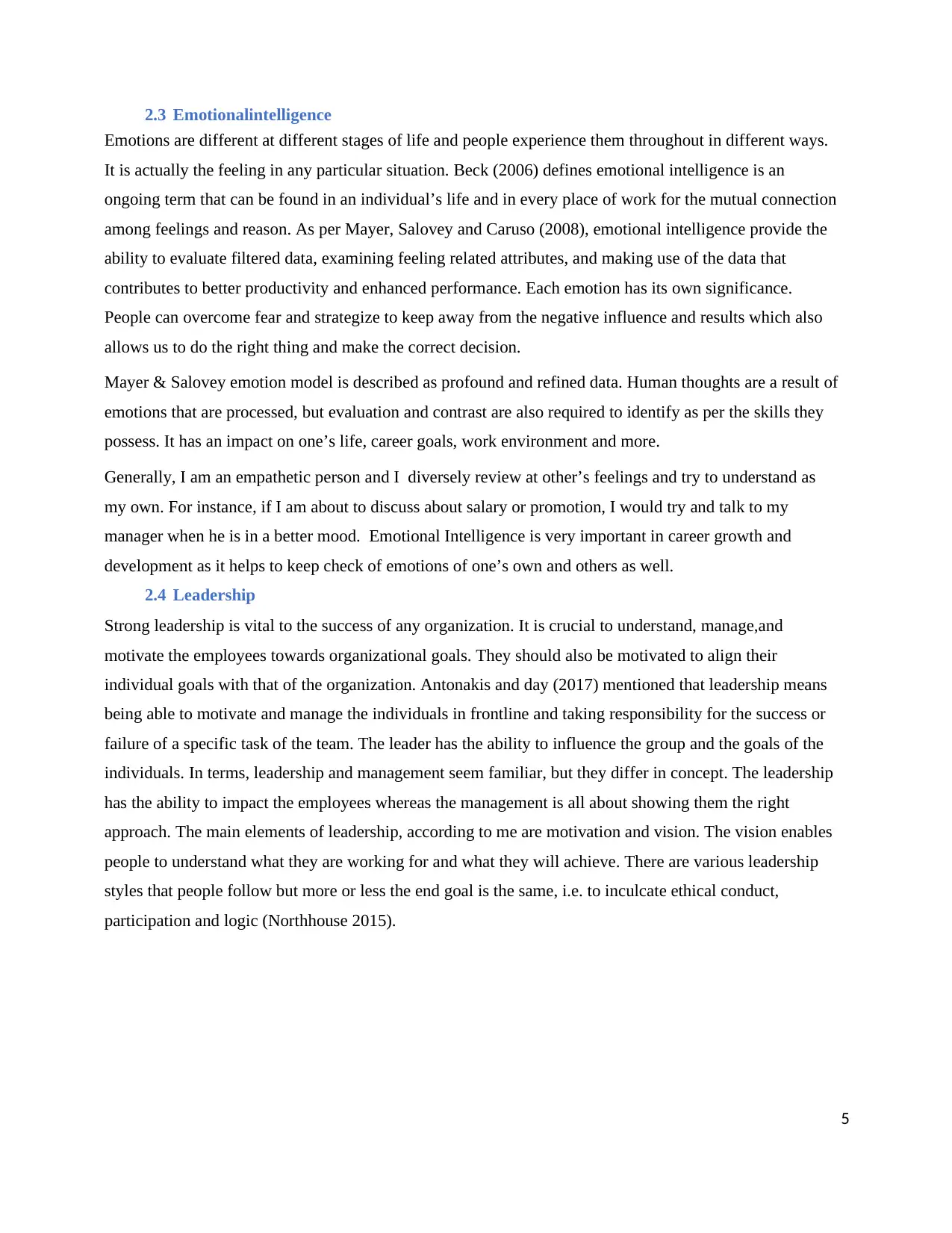
2.3 Emotionalintelligence
Emotions are different at different stages of life and people experience them throughout in different ways.
It is actually the feeling in any particular situation. Beck (2006) defines emotional intelligence is an
ongoing term that can be found in an individual’s life and in every place of work for the mutual connection
among feelings and reason. As per Mayer, Salovey and Caruso (2008), emotional intelligence provide the
ability to evaluate filtered data, examining feeling related attributes, and making use of the data that
contributes to better productivity and enhanced performance. Each emotion has its own significance.
People can overcome fear and strategize to keep away from the negative influence and results which also
allows us to do the right thing and make the correct decision.
Mayer & Salovey emotion model is described as profound and refined data. Human thoughts are a result of
emotions that are processed, but evaluation and contrast are also required to identify as per the skills they
possess. It has an impact on one’s life, career goals, work environment and more.
Generally, I am an empathetic person and I diversely review at other’s feelings and try to understand as
my own. For instance, if I am about to discuss about salary or promotion, I would try and talk to my
manager when he is in a better mood. Emotional Intelligence is very important in career growth and
development as it helps to keep check of emotions of one’s own and others as well.
2.4 Leadership
Strong leadership is vital to the success of any organization. It is crucial to understand, manage,and
motivate the employees towards organizational goals. They should also be motivated to align their
individual goals with that of the organization. Antonakis and day (2017) mentioned that leadership means
being able to motivate and manage the individuals in frontline and taking responsibility for the success or
failure of a specific task of the team. The leader has the ability to influence the group and the goals of the
individuals. In terms, leadership and management seem familiar, but they differ in concept. The leadership
has the ability to impact the employees whereas the management is all about showing them the right
approach. The main elements of leadership, according to me are motivation and vision. The vision enables
people to understand what they are working for and what they will achieve. There are various leadership
styles that people follow but more or less the end goal is the same, i.e. to inculcate ethical conduct,
participation and logic (Northhouse 2015).
5
Emotions are different at different stages of life and people experience them throughout in different ways.
It is actually the feeling in any particular situation. Beck (2006) defines emotional intelligence is an
ongoing term that can be found in an individual’s life and in every place of work for the mutual connection
among feelings and reason. As per Mayer, Salovey and Caruso (2008), emotional intelligence provide the
ability to evaluate filtered data, examining feeling related attributes, and making use of the data that
contributes to better productivity and enhanced performance. Each emotion has its own significance.
People can overcome fear and strategize to keep away from the negative influence and results which also
allows us to do the right thing and make the correct decision.
Mayer & Salovey emotion model is described as profound and refined data. Human thoughts are a result of
emotions that are processed, but evaluation and contrast are also required to identify as per the skills they
possess. It has an impact on one’s life, career goals, work environment and more.
Generally, I am an empathetic person and I diversely review at other’s feelings and try to understand as
my own. For instance, if I am about to discuss about salary or promotion, I would try and talk to my
manager when he is in a better mood. Emotional Intelligence is very important in career growth and
development as it helps to keep check of emotions of one’s own and others as well.
2.4 Leadership
Strong leadership is vital to the success of any organization. It is crucial to understand, manage,and
motivate the employees towards organizational goals. They should also be motivated to align their
individual goals with that of the organization. Antonakis and day (2017) mentioned that leadership means
being able to motivate and manage the individuals in frontline and taking responsibility for the success or
failure of a specific task of the team. The leader has the ability to influence the group and the goals of the
individuals. In terms, leadership and management seem familiar, but they differ in concept. The leadership
has the ability to impact the employees whereas the management is all about showing them the right
approach. The main elements of leadership, according to me are motivation and vision. The vision enables
people to understand what they are working for and what they will achieve. There are various leadership
styles that people follow but more or less the end goal is the same, i.e. to inculcate ethical conduct,
participation and logic (Northhouse 2015).
5
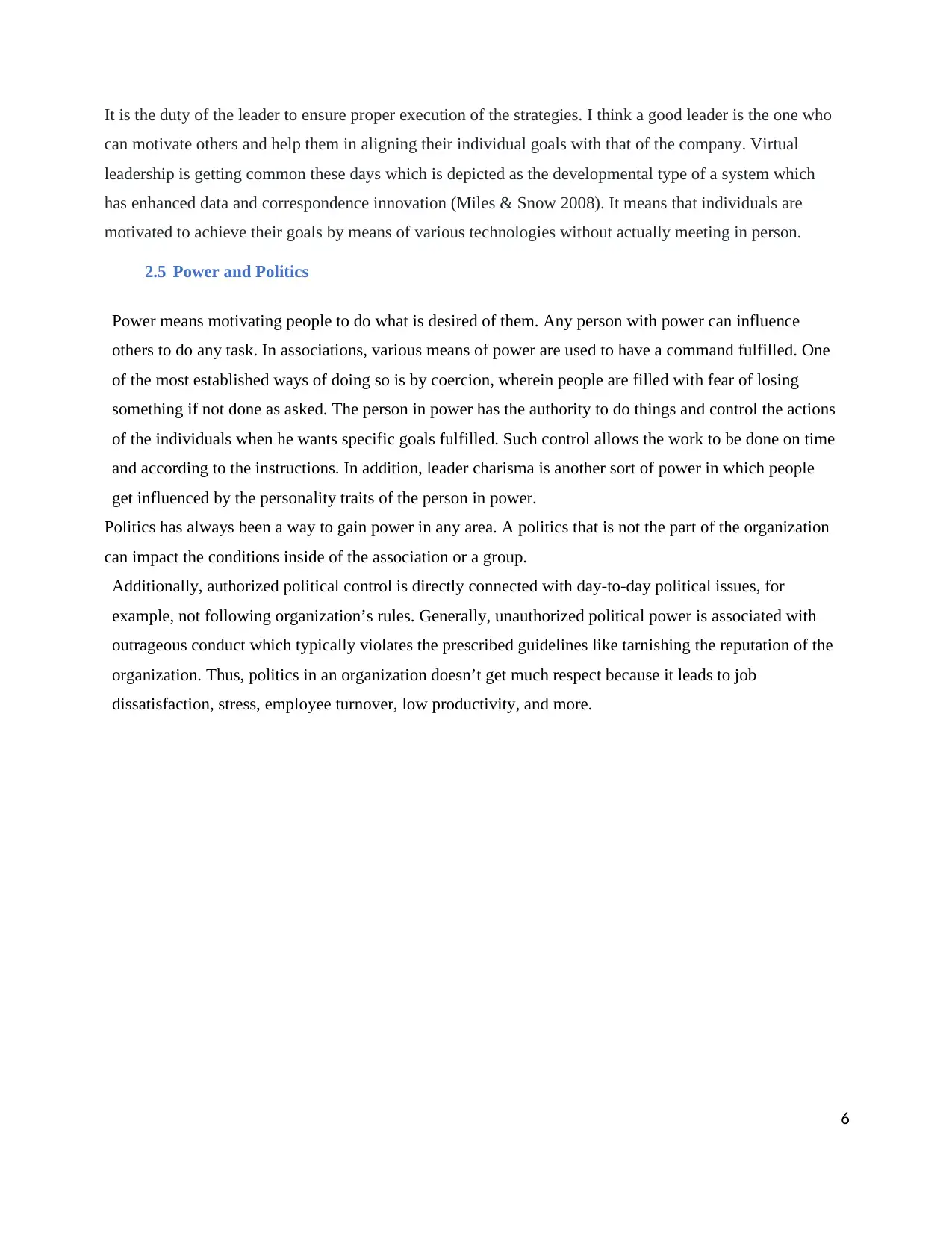
It is the duty of the leader to ensure proper execution of the strategies. I think a good leader is the one who
can motivate others and help them in aligning their individual goals with that of the company. Virtual
leadership is getting common these days which is depicted as the developmental type of a system which
has enhanced data and correspondence innovation (Miles & Snow 2008). It means that individuals are
motivated to achieve their goals by means of various technologies without actually meeting in person.
2.5 Power and Politics
Power means motivating people to do what is desired of them. Any person with power can influence
others to do any task. In associations, various means of power are used to have a command fulfilled. One
of the most established ways of doing so is by coercion, wherein people are filled with fear of losing
something if not done as asked. The person in power has the authority to do things and control the actions
of the individuals when he wants specific goals fulfilled. Such control allows the work to be done on time
and according to the instructions. In addition, leader charisma is another sort of power in which people
get influenced by the personality traits of the person in power.
Politics has always been a way to gain power in any area. A politics that is not the part of the organization
can impact the conditions inside of the association or a group.
Additionally, authorized political control is directly connected with day-to-day political issues, for
example, not following organization’s rules. Generally, unauthorized political power is associated with
outrageous conduct which typically violates the prescribed guidelines like tarnishing the reputation of the
organization. Thus, politics in an organization doesn’t get much respect because it leads to job
dissatisfaction, stress, employee turnover, low productivity, and more.
6
can motivate others and help them in aligning their individual goals with that of the company. Virtual
leadership is getting common these days which is depicted as the developmental type of a system which
has enhanced data and correspondence innovation (Miles & Snow 2008). It means that individuals are
motivated to achieve their goals by means of various technologies without actually meeting in person.
2.5 Power and Politics
Power means motivating people to do what is desired of them. Any person with power can influence
others to do any task. In associations, various means of power are used to have a command fulfilled. One
of the most established ways of doing so is by coercion, wherein people are filled with fear of losing
something if not done as asked. The person in power has the authority to do things and control the actions
of the individuals when he wants specific goals fulfilled. Such control allows the work to be done on time
and according to the instructions. In addition, leader charisma is another sort of power in which people
get influenced by the personality traits of the person in power.
Politics has always been a way to gain power in any area. A politics that is not the part of the organization
can impact the conditions inside of the association or a group.
Additionally, authorized political control is directly connected with day-to-day political issues, for
example, not following organization’s rules. Generally, unauthorized political power is associated with
outrageous conduct which typically violates the prescribed guidelines like tarnishing the reputation of the
organization. Thus, politics in an organization doesn’t get much respect because it leads to job
dissatisfaction, stress, employee turnover, low productivity, and more.
6
⊘ This is a preview!⊘
Do you want full access?
Subscribe today to unlock all pages.

Trusted by 1+ million students worldwide
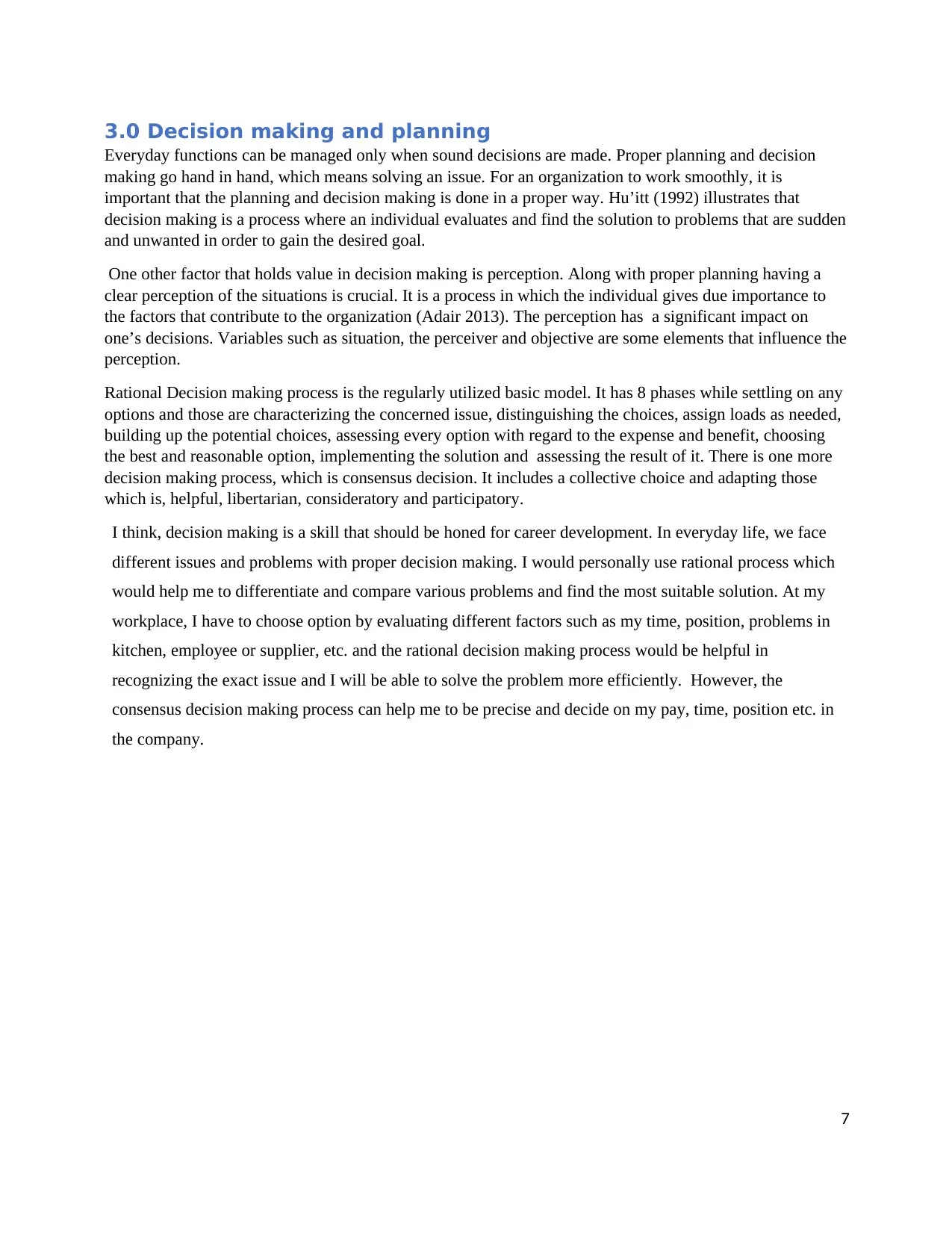
3.0 Decision making and planning
Everyday functions can be managed only when sound decisions are made. Proper planning and decision
making go hand in hand, which means solving an issue. For an organization to work smoothly, it is
important that the planning and decision making is done in a proper way. Hu’itt (1992) illustrates that
decision making is a process where an individual evaluates and find the solution to problems that are sudden
and unwanted in order to gain the desired goal.
One other factor that holds value in decision making is perception. Along with proper planning having a
clear perception of the situations is crucial. It is a process in which the individual gives due importance to
the factors that contribute to the organization (Adair 2013). The perception has a significant impact on
one’s decisions. Variables such as situation, the perceiver and objective are some elements that influence the
perception.
Rational Decision making process is the regularly utilized basic model. It has 8 phases while settling on any
options and those are characterizing the concerned issue, distinguishing the choices, assign loads as needed,
building up the potential choices, assessing every option with regard to the expense and benefit, choosing
the best and reasonable option, implementing the solution and assessing the result of it. There is one more
decision making process, which is consensus decision. It includes a collective choice and adapting those
which is, helpful, libertarian, consideratory and participatory.
I think, decision making is a skill that should be honed for career development. In everyday life, we face
different issues and problems with proper decision making. I would personally use rational process which
would help me to differentiate and compare various problems and find the most suitable solution. At my
workplace, I have to choose option by evaluating different factors such as my time, position, problems in
kitchen, employee or supplier, etc. and the rational decision making process would be helpful in
recognizing the exact issue and I will be able to solve the problem more efficiently. However, the
consensus decision making process can help me to be precise and decide on my pay, time, position etc. in
the company.
7
Everyday functions can be managed only when sound decisions are made. Proper planning and decision
making go hand in hand, which means solving an issue. For an organization to work smoothly, it is
important that the planning and decision making is done in a proper way. Hu’itt (1992) illustrates that
decision making is a process where an individual evaluates and find the solution to problems that are sudden
and unwanted in order to gain the desired goal.
One other factor that holds value in decision making is perception. Along with proper planning having a
clear perception of the situations is crucial. It is a process in which the individual gives due importance to
the factors that contribute to the organization (Adair 2013). The perception has a significant impact on
one’s decisions. Variables such as situation, the perceiver and objective are some elements that influence the
perception.
Rational Decision making process is the regularly utilized basic model. It has 8 phases while settling on any
options and those are characterizing the concerned issue, distinguishing the choices, assign loads as needed,
building up the potential choices, assessing every option with regard to the expense and benefit, choosing
the best and reasonable option, implementing the solution and assessing the result of it. There is one more
decision making process, which is consensus decision. It includes a collective choice and adapting those
which is, helpful, libertarian, consideratory and participatory.
I think, decision making is a skill that should be honed for career development. In everyday life, we face
different issues and problems with proper decision making. I would personally use rational process which
would help me to differentiate and compare various problems and find the most suitable solution. At my
workplace, I have to choose option by evaluating different factors such as my time, position, problems in
kitchen, employee or supplier, etc. and the rational decision making process would be helpful in
recognizing the exact issue and I will be able to solve the problem more efficiently. However, the
consensus decision making process can help me to be precise and decide on my pay, time, position etc. in
the company.
7
Paraphrase This Document
Need a fresh take? Get an instant paraphrase of this document with our AI Paraphraser
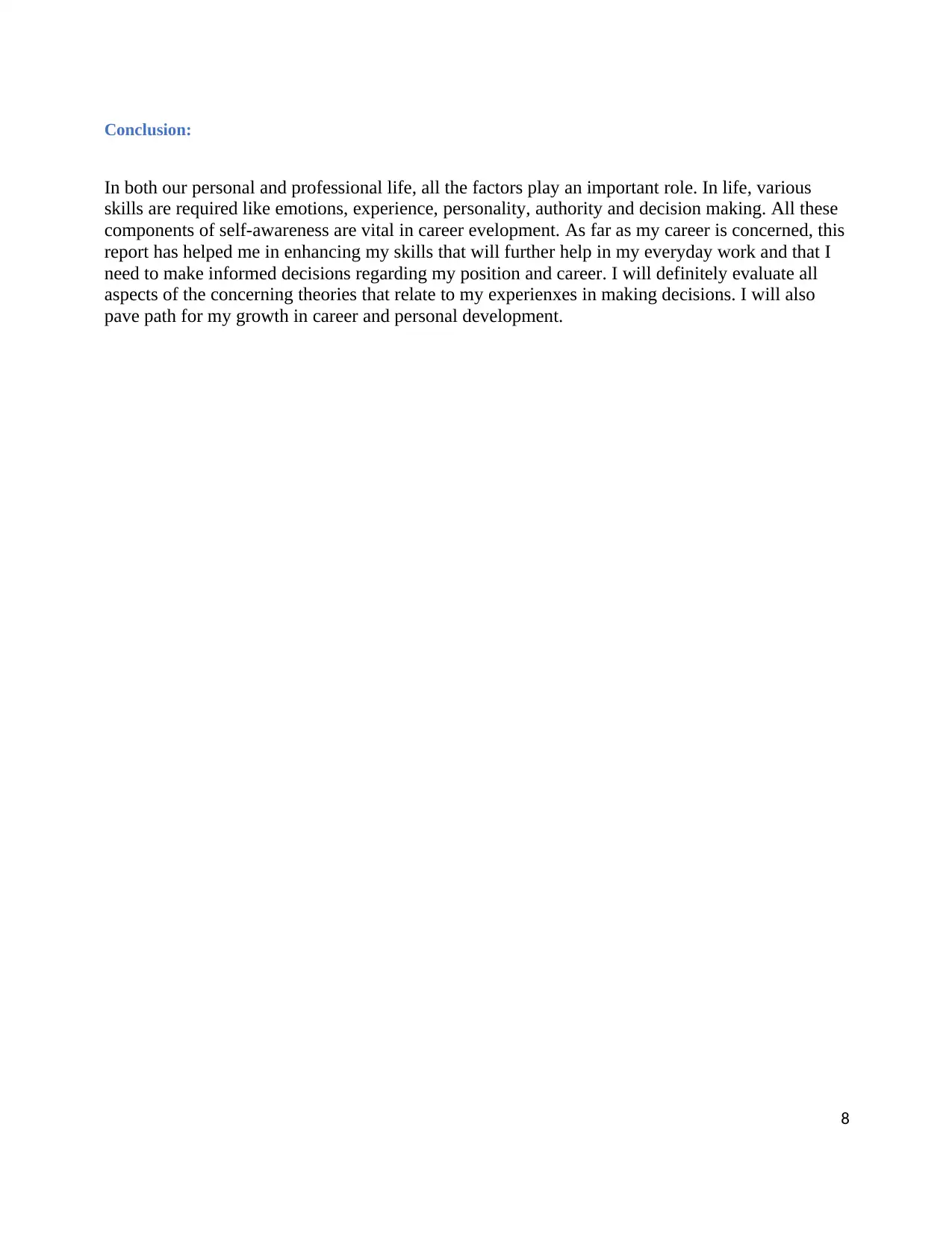
Conclusion:
In both our personal and professional life, all the factors play an important role. In life, various
skills are required like emotions, experience, personality, authority and decision making. All these
components of self-awareness are vital in career evelopment. As far as my career is concerned, this
report has helped me in enhancing my skills that will further help in my everyday work and that I
need to make informed decisions regarding my position and career. I will definitely evaluate all
aspects of the concerning theories that relate to my experienxes in making decisions. I will also
pave path for my growth in career and personal development.
8
In both our personal and professional life, all the factors play an important role. In life, various
skills are required like emotions, experience, personality, authority and decision making. All these
components of self-awareness are vital in career evelopment. As far as my career is concerned, this
report has helped me in enhancing my skills that will further help in my everyday work and that I
need to make informed decisions regarding my position and career. I will definitely evaluate all
aspects of the concerning theories that relate to my experienxes in making decisions. I will also
pave path for my growth in career and personal development.
8
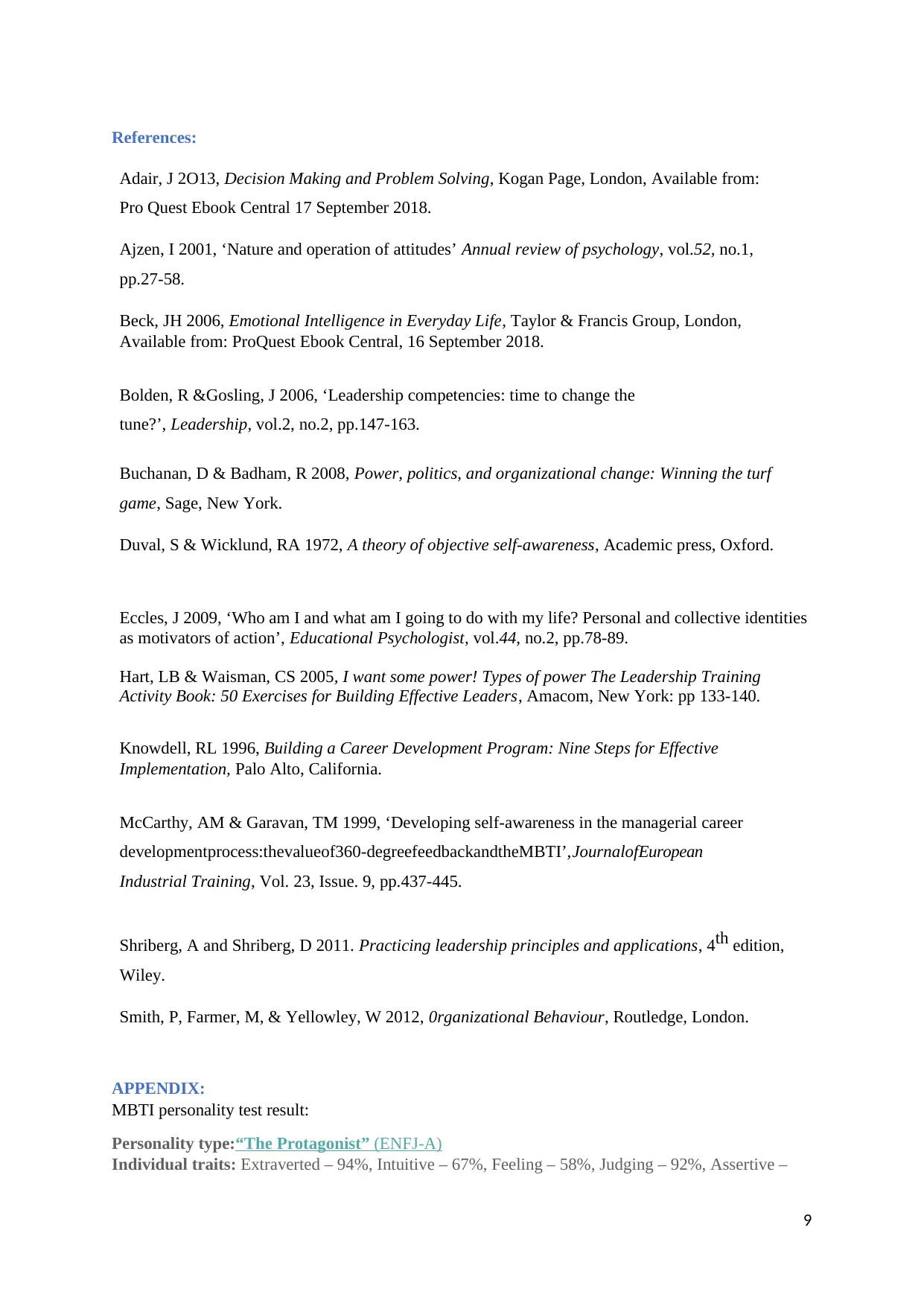
References:
Adair, J 2O13, Decision Making and Problem Solving, Kogan Page, London, Available from:
Pro Quest Ebook Central 17 September 2018.
Ajzen, I 2001, ‘Nature and operation of attitudes’ Annual review of psychology, vol.52, no.1,
pp.27-58.
Beck, JH 2006, Emotional Intelligence in Everyday Life, Taylor & Francis Group, London,
Available from: ProQuest Ebook Central, 16 September 2018.
Bolden, R &Gosling, J 2006, ‘Leadership competencies: time to change the
tune?’, Leadership, vol.2, no.2, pp.147-163.
Buchanan, D & Badham, R 2008, Power, politics, and organizational change: Winning the turf
game, Sage, New York.
Duval, S & Wicklund, RA 1972, A theory of objective self-awareness, Academic press, Oxford.
Eccles, J 2009, ‘Who am I and what am I going to do with my life? Personal and collective identities
as motivators of action’, Educational Psychologist, vol.44, no.2, pp.78-89.
Hart, LB & Waisman, CS 2005, I want some power! Types of power The Leadership Training
Activity Book: 50 Exercises for Building Effective Leaders, Amacom, New York: pp 133-140.
Knowdell, RL 1996, Building a Career Development Program: Nine Steps for Effective
Implementation, Palo Alto, California.
McCarthy, AM & Garavan, TM 1999, ‘Developing self‐awareness in the managerial career
developmentprocess:thevalueof360‐degreefeedbackandtheMBTI’,JournalofEuropean
Industrial Training, Vol. 23, Issue. 9, pp.437-445.
Shriberg, A and Shriberg, D 2011. Practicing leadership principles and applications, 4th edition,
Wiley.
Smith, P, Farmer, M, & Yellowley, W 2012, 0rganizational Behaviour, Routledge, London.
APPENDIX:
MBTI personality test result:
Personality type:“The Protagonist” (ENFJ-A)
Individual traits: Extraverted – 94%, Intuitive – 67%, Feeling – 58%, Judging – 92%, Assertive –
9
Adair, J 2O13, Decision Making and Problem Solving, Kogan Page, London, Available from:
Pro Quest Ebook Central 17 September 2018.
Ajzen, I 2001, ‘Nature and operation of attitudes’ Annual review of psychology, vol.52, no.1,
pp.27-58.
Beck, JH 2006, Emotional Intelligence in Everyday Life, Taylor & Francis Group, London,
Available from: ProQuest Ebook Central, 16 September 2018.
Bolden, R &Gosling, J 2006, ‘Leadership competencies: time to change the
tune?’, Leadership, vol.2, no.2, pp.147-163.
Buchanan, D & Badham, R 2008, Power, politics, and organizational change: Winning the turf
game, Sage, New York.
Duval, S & Wicklund, RA 1972, A theory of objective self-awareness, Academic press, Oxford.
Eccles, J 2009, ‘Who am I and what am I going to do with my life? Personal and collective identities
as motivators of action’, Educational Psychologist, vol.44, no.2, pp.78-89.
Hart, LB & Waisman, CS 2005, I want some power! Types of power The Leadership Training
Activity Book: 50 Exercises for Building Effective Leaders, Amacom, New York: pp 133-140.
Knowdell, RL 1996, Building a Career Development Program: Nine Steps for Effective
Implementation, Palo Alto, California.
McCarthy, AM & Garavan, TM 1999, ‘Developing self‐awareness in the managerial career
developmentprocess:thevalueof360‐degreefeedbackandtheMBTI’,JournalofEuropean
Industrial Training, Vol. 23, Issue. 9, pp.437-445.
Shriberg, A and Shriberg, D 2011. Practicing leadership principles and applications, 4th edition,
Wiley.
Smith, P, Farmer, M, & Yellowley, W 2012, 0rganizational Behaviour, Routledge, London.
APPENDIX:
MBTI personality test result:
Personality type:“The Protagonist” (ENFJ-A)
Individual traits: Extraverted – 94%, Intuitive – 67%, Feeling – 58%, Judging – 92%, Assertive –
9
⊘ This is a preview!⊘
Do you want full access?
Subscribe today to unlock all pages.

Trusted by 1+ million students worldwide
1 out of 9
Related Documents
Your All-in-One AI-Powered Toolkit for Academic Success.
+13062052269
info@desklib.com
Available 24*7 on WhatsApp / Email
![[object Object]](/_next/static/media/star-bottom.7253800d.svg)
Unlock your academic potential
Copyright © 2020–2025 A2Z Services. All Rights Reserved. Developed and managed by ZUCOL.




